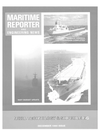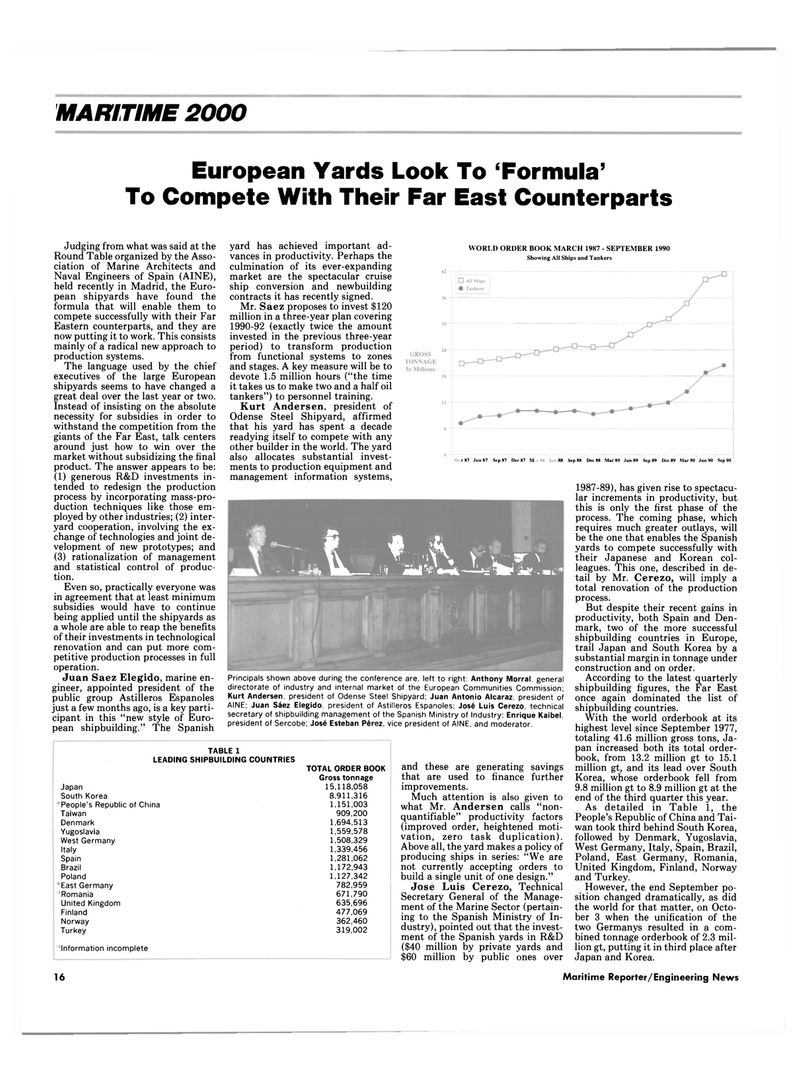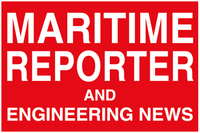
Page 14: of Maritime Reporter Magazine (December 1990)
Read this page in Pdf, Flash or Html5 edition of December 1990 Maritime Reporter Magazine
MARITIME 2000
European Yards Look To 'Formula'
To Compete With Their Far East Counterparts
Judging from what was said at the
Round Table organized by the Asso- ciation of Marine Architects and
Naval Engineers of Spain (AINE), held recently in Madrid, the Euro- pean shipyards have found the formula that will enable them to compete successfully with their Far
Eastern counterparts, and they are now putting it to work. This consists mainly of a radical new approach to production systems.
The language used by the chief executives of the large European shipyards seems to have changed a great deal over the last year or two.
Instead of insisting on the absolute necessity for subsidies in order to withstand the competition from the giants of the Far East, talk centers around just how to win over the market without subsidizing the final product. The answer appears to be: (1) generous R&D investments in- tended to redesign the production process by incorporating mass-pro- duction techniques like those em- ployed by other industries; (2) inter- yard cooperation, involving the ex- change of technologies and joint de- velopment of new prototypes; and (3) rationalization of management and statistical control of produc- tion.
Even so, practically everyone was in agreement that at least minimum subsidies would have to continue being applied until the shipyards as a whole are able to reap the benefits of their investments in technological renovation and can put more com- petitive production processes in full operation.
Juan Saez Elegido, marine en- gineer, appointed president of the public group Astilleros Espanoles just a few months ago, is a key parti- cipant in this "new style of Euro- pean shipbuilding." The Spanish yard has achieved important ad- vances in productivity. Perhaps the culmination of its ever-expanding market are the spectacular cruise ship conversion and newbuilding contracts it has recently signed.
Mr. Saez proposes to invest $120 million in a three-year plan covering 1990-92 (exactly twice the amount invested in the previous three-year period) to transform production from functional systems to zones and stages. A key measure will be to devote 1.5 million hours ("the time it takes us to make two and a half oil tankers") to personnel training.
Kurt Andersen, president of
Odense Steel Shipyard, affirmed that his yard has spent a decade readying itself to compete with any other builder in the world. The yard also allocates substantial invest- ments to production equipment and management information systems,
WORM) ORDER BOOK MARCH 1987 - SEPTEMBER 1990
Showing All Ships and Tankers r 87 Jun 87 Sep 87 Dec 87 M; 1 ft * f , > ^ >
U J* -
Principals shown above during the conference are. left to right: Anthony Morral. general directorate of industry and internal market of the European Communities Commission;
Kurt Andersen, president of Odense Steel Shipyard; Juan Antonio Alcaraz, president of
AINE; Juan S^ez Elegido. president of Astilleros Espanoles; Jos6 Luis Cerezo. technical secretary of shipbuilding management of the Spanish Ministry of Industry; Enrique Kaibel. president of Sercobe; Jos6 Esteban P6rez. vice president of AINE, and moderator.
TABLE 1
LEADING SHIPBUILDING COUNTRIES
TOTAL ORDER BOOK
Gross tonnage
Japan 15,118,058
South Korea 8.911.316
People's Republic of China 1,151,003
Taiwan 909,200
Denmark 1,694,513
Yugoslavia 1,559,578
West Germany 1.508,329
Italy 1,339.456
Spain 1,281,062
Brazil 1.172,943
Poland 1,127,342
East Germany 782,959 ! Romania 671,790
United Kingdom 635,696
Finland 477,069
Norway 362,460
Turkey 319,002 'Information incomplete and these are generating savings that are used to finance further improvements.
Much attention is also given to what Mr. Andersen calls "non- quantifiable" productivity factors (improved order, heightened moti- vation, zero task duplication).
Above all, the yard makes a policy of producing ships in series: "We are not currently accepting orders to build a single unit of one design."
Jose Luis Cerezo, Technical
Secretary General of the Manage- ment of the Marine Sector (pertain- ing to the Spanish Ministry of In- dustry), pointed out that the invest- ment of the Spanish yards in R&D ($40 million by private yards and $60 million by public ones over
XX Sep 88 Dec 88 Mar 89 Jun Sep 89 Dec 89 Mar 90 Jun 90 Sep 90 1987-89), has given rise to spectacu- lar increments in productivity, but this is only the first phase of the process. The coming phase, which requires much greater outlays, will be the one that enables the Spanish yards to compete successfully with their Japanese and Korean col- leagues. This one, described in de- tail by Mr. Cerezo, will imply a total renovation of the production process.
But despite their recent gains in productivity, both Spain and Den- mark, two of the more successful shipbuilding countries in Europe, trail Japan and South Korea by a substantial margin in tonnage under construction and on order.
According to the latest quarterly shipbuilding figures, the Far East once again dominated the list of shipbuilding countries.
With the world orderbook at its highest level since September 1977, totaling 41.6 million gross tons, Ja- pan increased both its total order- book, from 13.2 million gt to 15.1 million gt, and its lead over South
Korea, whose orderbook fell from 9.8 million gt to 8.9 million gt at the end of the third quarter this year.
As detailed in Table 1, the
People's Republic of China and Tai- wan took third behind South Korea, followed by Denmark, Yugoslavia,
West Germany, Italy, Spain, Brazil,
Poland, East Germany, Romania,
United Kingdom, Finland, Norway and Turkey.
However, the end September po- sition changed dramatically, as did the world for that matter, on Octo- ber 3 when the unification of the two Germanys resulted in a com- bined tonnage orderbook of 2.3 mil- lion gt, putting it in third place after
Japan and Korea. 16 Maritime Reporter/Engineering News

 13
13

 15
15
